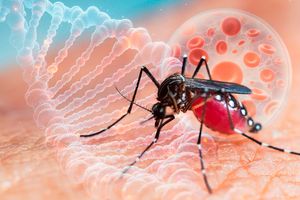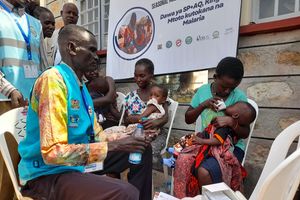Ministry releases list of counties with high prevalence of malaria

Health PS Mary Muthoni says the ministry has distributed nets to 8,902,013 people in 14 counties, which is 59 per cent.
What you need to know:
- In the last 12 months, Kenya recorded a total of 5,447,220 malaria cases, with Busia County leading with 231,307 cases.
You are six times more likely to get malaria if you visit Busia, Tana River, Kakamega, Bungoma, Kilifi, Kisumu, Trans Nzoia, Elgeyo Marakwet and Nandi counties, according to the latest data from the Ministry of Health.
At least 75 per cent of the Kenyan population is at risk of contracting the disease, which in 2023 accounted for at least 15 percent of outpatient hospital visits nationally and 58 percent in the eight counties.
On Monday, the State Department of Public Health and Professional Standards announced that 22 counties are currently receiving 15.3 million bed nets to fight malaria through an initiative that is supported by the US President’s Malaria Initiative (PMI). Over the past 12 months, Kenya recorded a total of 5,447,220 malaria cases, with Busia County leading with 231,307 cases.
The Ministry of Health, citing Budalang’i, noted that cross-border transmission along the Busia border, drug-resistant malaria parasites and climate change, which is causing unpredictable rainfall and flooding, are the main factors fuelling the rise in malaria infections in the country.
According to the ministry, data from routine monitoring of insecticide sensitivity and changes, as well as continuous generation of evidence on mosquito behaviour, shows that insecticide resistance in mosquitoes and changes in biting behaviour are another headache the country is grappling with as efforts to eliminate malaria for good intensify.
"The ministry has an elaborate surveillance system that conducts both routine epidemiological and periodic entomological surveillance. Integrated Disease Surveillance System (IDSR) is crucial in detecting malaria upsurges and epidemics for prompt response," Public Health and Professional Standards Principal Secretary Mary Muthoni told the Nation. The Ministry of Health also highlights that the total number of households registered in the 22 counties is 4,748,269 out of a total registered population of 29,011,323. The Ministry of Health has distributed nets to 8,902,013 people in 14 counties, which translates to 59 percent of the total population.
"Distribution has concluded in 13 counties, namely Homa Bay, Kisii, Nyamira, Kisumu, Siaya, Migori, Mombasa, Kwale, Tana River, Lamu, Taita Taveta, Kakamega and Vihiga, but is still ongoing in Bungoma," Ms Muthoni told the Nation on Monday.
"Busia has a malaria prevalence of 38.5 per cent against a national prevalence of six per cent, which is why we introduced high-impact indoor residual spraying, which saw 95 per cent of target structures sprayed in March this year. Mass net distribution will also be done where 224,329 registered households with a population of 1,458,774 will get 773,936 long-lasting insecticidal nets," the PS said,adding that Butula Sub-county had been overlooked in the ordering process.
"This has been corrected and Kemsa [Kenya Medical Supplies Authority] is in the process of transporting nets to Butula Sub-county to ensure all beneficiaries are covered," she said.
According to the Ministry of Health, research trials for spatial repellents in Busia (Teso South and Teso North) have also produced promising results, with a 32.1 percent reduction in malaria cases. Plans are now underway to scale up the use of spatial repellents amid an ongoing evaluation in Bunyala South.
The Ministry of Health is also using the malaria vaccine to protect children under the age of five from severe malaria, with the vaccine administered at six, seven, nine and 24 months.
Ms Muthoni told the Nation 84 percent of the target population had received the first dose and 40 percent had received the fourth dose. The fourth dose is usually given at two years of age, when children have completed other vaccines after the first year. The PS stressed on the need to encourage communities, and especially mothers, to increase uptake possibly through community health promoters.
"Malaria incidences are decreasing as noted by a decline from 763/1,000 cases in December 2023 to 517/1,000 in June 2024," Ms Muthoni said.
She told the Nation that the re was a high malaria burden in Tororo and Busia District in Uganda, which border Kenya. Because mosquitoes don't recognise borders, the Great Lakes Malaria Initiative (GLMI) is discussing how to manage the disease across borders.
In November last year, the Centres for Disease Control and Prevention (CDC) warned that one of the deadliest mosquito species, which can transmit two parasites at once, had travelled by road in containers from Ethiopia to Kenya and would cause malaria infections in the country to soar.
The anopheles stephensi mosquito, which can transmit both the plasmodium falciparum and plasmodium vivax malaria parasites, making it very dangerous and deadly, was found in Lodwar and Turkana, in addition to reports of being found in Marsabit.
The CDC noted that the mosquito breed most likely entered the country by road from Ethiopia, as mosquito sampling in Marsabit conducted in Moyale, Laisamis and Saku sub-counties focused on urban and rural areas along the northern transport corridor between Kenya and Ethiopia, while sampling in Turkana focused on Lodwar, the county capital and a major town on the land transport corridor to Kenya.
Its most alarming characteristics make it particularly adept at exploiting the built environment in areas with no history of risk.





